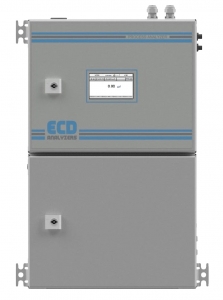Eco-Friendly CA-6 Colorimetric Analyzer Helps Verify Copper Removal from Industrial Wastewater
Ideal for Metal Processes, Electroplating, Wiring Production, Electronic Devices & More
 Anaheim, CA—June 24, 2019—With its adjustable cycle time that minimizes costly reagent use and low maintenance, process engineers tasked with treating industrial wastewater containing copper (Cu) will find the precision CA-6 Colorimetric Copper Analyzer from Electro-Chemical Devices (ECD) helps them protect valuable water resources.
Anaheim, CA—June 24, 2019—With its adjustable cycle time that minimizes costly reagent use and low maintenance, process engineers tasked with treating industrial wastewater containing copper (Cu) will find the precision CA-6 Colorimetric Copper Analyzer from Electro-Chemical Devices (ECD) helps them protect valuable water resources.
ECD’s CA-6 Copper Analyzer is an on-line sequential sampling analyzer. It automatically performs a controlled sequence of sampling, analysis and then results processing is performed and repeated using colorimetric methods. The colorimetric method of water analysis relies on an LED light source and a heated colorimetric cell, which has been designed for measuring trace amounts of Cu in water.
The CA-6 Colorimetric Analyzer measures Cu using the differential photometric absorbance bathocuproine method. The copper (I) ions form an orange-colored complex with the bathocuproine in a buffered solution at pH 4,5. Any copper (II) ions present in the water sample are previously reduced to copper (I) ions before the complex is formed. The absorbance intensity is proportional to the silica concentration in the sample and is determined at 470 nm.
The versatile CA-6 Colorimetric Analyzer can be configured to measure copper or a wide range of other substances with a choice of multiple parameters: ppb, ppm and mg/L. It measures copper over a wide range depending on the cell size chosen–from trace levels of 0.05 to 1 mg/L (26 mm cell) 0,1 to 3 mg/L (16 mm cell) up to 150 mg/L with internal dilution. It is highly dependable too, with reproducibility also based on the cell size: (1) ±20 ppb or ±5%, whichever is greater (26 mm cell) or (2) ±50 ppb ±5%, whichever is greater (16 mm cell).
Highly efficient for a low cost of ownership, the CA-6 Colorimetric Analyzer features low reagent consumption to lower operating costs, reduce special storage and disposal costs of reagents and minimize technician maintenance labor time. The CA-6 consumes only 1L (0.26 US gal) R1, R2 and 2L (0.53 US gal) R3 for the 16 mm cell /2L (0.53 US gal) R1, R2 and 4L (1.06 US gal) R3 for the 26 mm cell of each reagent every 30 days with 15 minute analysis frequency.
The CA-6 Colorimetric Analyzer is equipped with a graphic touchscreen interface showing measured values and status information. It provides users with easy access to menus and functions in multiple languages. There is an integrated data logger onboard with USB download capability for history tracking.
Outputs provided with the CA-6 Analyzer include two 4-20 mA outputs for measured data, and it also includes a Modbus compatible RS485 RTU. Four programmable SPDT relays are available to provide alarm capability.
The CA-6 Colorimetric Analyzers is designed with two compartments that separate critical electronics from the wet process. The standard model is recommended for indoor use and rated NEMA IP54 for dust and water ingress. The operating temperature range of the CA-6 Analyzer is 41 to 113 °F (5 to 45 °C).
The manufacture of electrical wiring, electronic devices and components, metals plating and processing, motors, sensors and even performance fabrics are some of the many industrial uses of copper (Cu). There are several processes available to remove heavy metals such as Cu from wastewater, which involve technologies such as adsorption, anaerobic treatment, membrane filtration, cementation and electro-dialysis.
All of the copper abatement processes have one thing in common—they require the accurate measurement of Cu before effluent discharge into the water system. The treatment of Cu in wastewater is complicated by the fact that Cu is both necessary to the normal functioning of the human body at the right levels and also is toxic to the body at higher than normal levels. For this reason, the U.S. Environmental Protection Agency (EPA) has set a Cu maximum contaminant level (MCL) of 1.3 mg/L. The symptoms of over-exposure to Cu in water can include severe nausea, vomiting, gastrointestinal issues, muscle pain, anemia, liver or kidney failure and even death.
About Electro-Chemical Devices
Electro-Chemical Devices (ECD) is a manufacturer of liquid analytical process instrumentation. Founded in 1977, ECD has been in business for over 40 years and has built its industry leading reputation by its commitment to customers through this basic approach: Provide quality products, develop technical innovations and provide responsive, knowledgeable service.
ECD Company Contact: Eric Kim ● ECD Address: 1500 N. Kellogg Dr., Anaheim, CA 92807 USA
Web: www.ecdi.com ● Email: [email protected] ● Tel: 800-729-1333 Tel: 714-695-0051 ● Fax: 714-695-0057
Editor’s Contact: Randy Brown ● Tel: 909-223-6700 ● Email [email protected]
